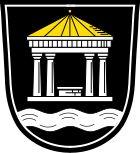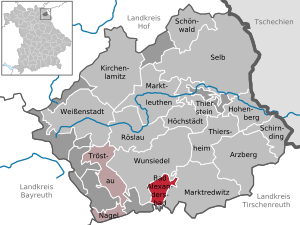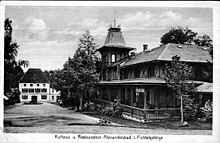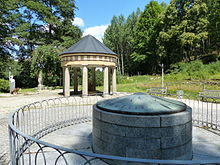Bad Alexandersbad
| coat of arms | Germany map | |
|---|---|---|

|
Coordinates: 50 ° 1 ' N , 12 ° 1' E |
|
| Basic data | ||
| State : | Bavaria | |
| Administrative region : | Upper Franconia | |
| County : | Wunsiedel in the Fichtel Mountains | |
| Management Community : | Tröstau | |
| Height : | 578 m above sea level NHN | |
| Area : | 8.94 km 2 | |
| Residents: | 966 (Dec. 31, 2019) | |
| Population density : | 108 inhabitants per km 2 | |
| Postal code : | 95680 | |
| Area code : | 09232 | |
| License plate : | WUN, MAK, REH , SEL | |
| Community key : | 09 4 79 111 | |
| Community structure: | 5 districts | |
| Address of the municipal administration: |
Markgrafenstrasse 28 95680 Bad Alexandersbad |
|
| Website : | ||
| First Mayor : | Anita Berek ( SPD ) | |
| Location of the municipality of Bad Alexandersbad in the district of Wunsiedel in the Fichtel Mountains | ||
Bad Alexandersbad , until 1979 Alexandersbad , is a municipality in the Upper Franconian district of Wunsiedel in the Fichtel Mountains . Bad Alexandersbad is a mineral and mud spa .
geography
Neighboring communities
Neighboring communities are the city of Wunsiedel in the west and the city of Marktredwitz in the east . In the south, the parish corridor borders on a parish -free area .
Community structure
There are five districts:
- Bad Alexandersbad
- Dünkelhammer
- Small users
- Sichersreuth
- Tiefenbach
history
18th century
The place was named after the last Margrave of Ansbach-Bayreuth, Margrave Christian Carl Alexander . The decisive factor was the discovery of a healing spring in the Heuleite valley in 1734 by the Sichersreuther farmer Wolfgang Brodmerkel. According to tradition, the farmer was able to cure his severe gout disease within a year with a drinking cure with the regulations from Karlsbad. Word of this miraculous healing got around in the area and so many people came to the Sichersreuther Brunnen to find healing too.
In 1741 the Wunsiedler governor Baron von Lindenfels had the spring cleaned and set with a “hollowed piece of fir tree”. The source was ignored for six years. It was not until 1747 that governor von Schönfeld campaigned for the Sichersreuth spring with Margrave Friedrich in Bayreuth. Thereupon the margrave commissioned his personal physician Wagner to examine the source, but he was unable to carry out the order for a long time "due to illness and other activities". In 1751 and 1752 the fountain was fenced in, a fountain supervisor was employed and the old fountain house was built on a stately account. During this time, the well water was filled into jugs and shipped.
Real progress with the Sichersreuther Bronnen was only made under Margrave Alexander, who succeeded the deceased last Margrave of Bayreuth. Although the decision was made as early as 1779 to build a large building to accommodate the bathers and to beautify the area by planting deciduous trees, work did not begin until 1781. Margrave Alexander ordered his building inspector Johann Gottlieb Riedel and the court gardener Johann Georg Rosengart to Sichersreuth to coordinate and monitor the building work. At the source the picket fence was removed and a stone border was made. The Bayreuth court nursery laid out parks, avenues and walking paths, so the avenue from the fountain to the new bathhouse was marked out and 29 trees were planted in four rows. In 1782 and 1783, Margrave Alexander had a new bathhouse built for the increasing number of spa guests under the supervision of Johann Gottlieb Riedel, today's Margravial Palace . The bathhouse was very comfortably built and equipped for the time. In order to maintain a good indoor climate, the stone walls were completely lined with bricks inside. A side wing was added to the left and right of the main building, Corps de Logis. In the main building there was an “extremely beautiful hall, where the spa guests come together, eat, drink, play and have fun; it is so big that it can comfortably hold seventy or more people ”. There were around 20 rooms in the side wings, plus rooms for servants.
At the inauguration of the building, a serious construction defect was noticed, which after the opulent meal "led the guests across the courtyard according to rural custom": There were no toilets in the entire building . Smaller additions to the side wings later eliminated this deficiency. On the east side of the building, a marble plaque with a Latin inscription tells of the origins of the bathhouse, which translates as:
ALEXANDER Margrave of Brandenburg, Duke in Prussia, Burgrave of Nuremberg PP 1783. You, kind reader, admire this house that shines in this solitude, stop being amazed, a benevolent one Prince built it, who built even more noble monuments.
Margrave Alexander gave the new place his name - this is how Alexandersbad was created.
19th century
In the following years the place developed into a post-spa for the nearby Bohemian baths, the water from the Sichersreuther fountain was sent to the royal court in Berlin, where it was used "primarily to dilute the wine". The young health resort had high visitors in 1805 when the Prussian King Friedrich Wilhelm III. and Queen Luise stayed in Alexandersbad for three weeks. While the Queen was recovering in Alexandersbad, the fortunes of Prussia were directed from the small seaside resort in the Bayreuth region, and many high-ranking personalities were present during this time.
In 1838 the first Bavarian cold water healing facility was founded in Alexandersbad and the old spa house was built. In the period that followed, the owners of the health resort changed frequently, and there were ups and downs in the health resort. On August 1, 1868, the doctor Emil Cordes took over the facility as owner, which he initially managed himself and from 1887 onwards by employed doctors. After taking over the steel bath and founding a stock corporation in 1881, he had a new spa house built in 1884.
20th century
Due to the turmoil of war at the beginning of the 20th century, the spa and bathing operations came to a complete standstill, the spa houses and inns in the village were used as children's homes and hospital. The political community of Sichersreuth, to which the bath belonged as a district, was renamed in 1937 to the more well-known and now larger Alexandersbad. In 1939, part of the previously independent municipality of Oberredwitz was incorporated.
After the end of the war, the Sisters of the Teutonic Order found a new sphere of activity in Alexandersbad in 1946. They looked after a hospital for the disabled in the Old Kurhaus, which later became a home for the elderly, and the Inner Mission created a retraining center for war disabled in the castle . In the 1950s, the Teutonic Order acquired the entire facilities of the spa and bathing establishment in Alexandersbad. With the establishment of the Evangelical Lutheran Folk High School, today the Evangelical Education and Conference Center, which was opened in 1958, efforts to wake Alexandersbad from its slumber were further boosted. The political community invested large sums in new infrastructure and in 1968 the mineral spring was again recognized by the state and Alexandersbad was given the name climatic health resort . Other important stops on the way to the spa were the expansion of the bed capacity with two large new hotel buildings and the construction of a modern spa center in 1973. The grounds around the margravial castle were redesigned. On December 20, 1976, the Bavarian Ministry of the Interior awarded the name of a spa. The communal independence of the community could be maintained in 1978 through the formation of an administrative community with the towns of Nagel and Tröstau and since July 1, 1979, the official community name has been preceded by the title Bad . Other major projects were the Haus des Gastes and a private congress and conference center. With the renovation of the old Kurhaus between 1992 and 1994, a piece of the history of Bad Alexandersbad was saved from deterioration.
21st century
After the changes in the health and spa system, it was necessary to realign the range of courses. Since 2007, the historic spa area in the town center and the spa center with local remedies have been redesigned in the smallest spa in Bavaria using the instruments of the village renewal program. Numerous accompanying measures were implemented in order to put the new range of cures on a solid footing. Bad Alexandersbad has been using regenerative energies as a "bioenergy spa" since 2008. The local heating supply, which has been in operation since October 2011, with over two kilometers of heat conduction and heat generation from biogas and wood chips with an output of 2.3 megawatts, is the largest of its kind in the Fichtelgebirge. With the title “Bad Alexandersbad lights”, Bad Alexandersbad was the first municipality in Bavaria in 2011 to switch all of its public lighting from conventional technology to LED. The Kinderhaus Königin Luise , founded in 2008, offers a range of childcare options that is unique in Bavaria for local and regional children as well as for spa, holiday and seminar guests.
The historical bath house development association has been trying to rebuild the historical bath house on Quellenplatz, which was demolished in 1965, since 2013.
The new Kurmittelhaus, the ALEXBAD, opened in May 2017. Attached to the historic old spa house, it offers a comprehensive range of health and therapy options. The Alexanderplatz in front of it was completed in 2019. The former spa and sports hotel directly behind the ALEXBAD was demolished in 2017, the area of 14,000 m² is ready for structural development.
Population development
Between 1988 and 2018, the population decreased from 1214 to 956 by 258 or 21.3%.
|
|
politics
The 2020 local elections resulted in the following distribution of seats in the local council (compared to 2014):
- CSU 5 seats (−1)
- General Association of Voters / Free Association of Voters 4 seats (+1)
- SPD 3 seats (± 0)
From 2008 to 2020 Peter Berek from the CSU, since May 1, 2020 District Administrator of the district of Wunsiedel in the Fichtelgebirge , was mayor of the municipality.
Anita Berek, Peter Berek's cousin, was elected as the new mayor in the Bavarian municipal elections on March 15, 2020 . With a turnout of 70.2 percent, the non-party applicant , who stood for the SPD , received 53.6 percent of all votes.
Culture and sights
- ALEXBAD, new spa center with panorama pool, based on plans by the architects Brückner & Brückner
- Margravial Alexandersbad Palace , the former bathhouse with remains of the historical spa facilities
- Luisenquelle (Eisensäuerling)
- historical old Kurhaus
- Queen Luise nature trail
- Wenderner stone for small users
- Wisentbrunnen behind the old spa house
Economy and Infrastructure
In June 2010, there were a total of 297 employees subject to social security contributions at the place of residence and 578 at the place of work . There is a wood turner's workshop in the manufacturing and construction trades . There are 19 farms with an agricultural area of 683 hectares. Of this, 475 hectares were arable land and 208 hectares were permanent green space.
Personalities
King Friedrich Wilhelm III. von Prussia and Queen Luise stayed in Alexandersbad for three weeks in 1805; a memorial stone on the way to Luisenburg reminds of this visit. On June 30, 1785 and April 25, 1820, Johann Wolfgang von Goethe visited Alexandersbad.
literature
- Emil Neidiger: The Sichersreuther Brunnen - Alexandersbad in the Fichtelgebirge. In: Franconian bathing trips in old and new times, Frankenbund, Würzburg 1965, p. 70 f.
Web links
- http://www.bayern-fichtelgebirge.de/gewaesserkunde/9.htm?9
- Entry on the coat of arms of Bad Alexandersbad in the database of the House of Bavarian History
Individual evidence
- ↑ "Data 2" sheet, Statistical Report A1200C 202041 Population of the municipalities, districts and administrative districts 1st quarter 2020 (population based on the 2011 census) ( help ).
- ^ Municipality of Bad Alexandersbad: Municipal Council. First mayor. Retrieved May 23, 2020 .
- ↑ http://www.bayerische-landesbibliothek-online.de/orte/ortssuche_action.html?val=1298&attr=590&modus=automat&tempus=20101016/171046&hodie=20101016/171054
- ↑ Hubertus Averbeck: From the cold water cure to physical therapy: considerations on people and at the time of the most important developments in the 19th century. Europäische Hochschulverlag, Bremen 2012, ISBN 978-3-86741-782-2 , p. 405 f.
- ^ Wilhelm Volkert (ed.): Handbook of Bavarian offices, communities and courts 1799–1980 . CH Beck, Munich 1983, ISBN 3-406-09669-7 , p. 598 .
- ^ Federal Statistical Office (ed.): Historical municipality directory for the Federal Republic of Germany. Name, border and key number changes for municipalities, counties and administrative districts from May 27, 1970 to December 31, 1982 . W. Kohlhammer GmbH, Stuttgart / Mainz 1983, ISBN 3-17-003263-1 , p. 701 .
- ↑ http://badalexandersbad.de/kraftorte/historisches-badehaus/ accessed on February 8, 2017
- ^ District of Wunsiedel: District election of Wunsiedel i. Fichtelgebirge , March 15, 2020, accessed on March 17, 2020.
- ↑ Peggy Biczysko: Declaration of love to the district , in: Frankenpost , March 15, 2020, accessed on March 17, 2020.
- ↑ TV Oberfranken : Local election 2020 in Upper Franconia: District of Wunsiedel , March 15, 2020, accessed on March 17, 2020.
- ^ Frankenpost : Will Bad Alexandersbad remain in Berek's hands? , July 12, 2019, accessed on March 17, 2020.
- ↑ Width and security , in: Bayerische Staatszeitung , May 11, 2018, accessed on April 17, 2020.
- ↑ Architecture Prize for the Alexbad , in: Frankenpost , September 26, 2018, accessed on April 17, 2020.
- ↑ Wisentbrunnen










